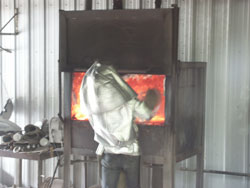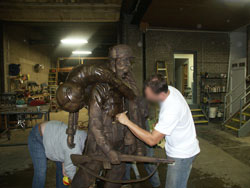- Home » Custom process
Custom process
The following steps and photos outline the progression of the lost wax process.
1):The first step is to create an original piece using either clay or wax.

2):A rubber mold and an outer mother mold that holds the shape is then made of the original work. Rubber is the chosen material, because it is able to capture all the intricate details of the original, allowing for a true reproduction.

3):Hot wax is then poured or brushed into the mold. Once the hot wax has hardened, it is removed and the wax replica of the original is revealed.
4):After the original wax is removed from the rubber mold, the replica is hand detailed to match the original.
5):Wax rods, called gates, are applied to the wax replica. This allows for the wax to be removed and creates an even flow of molten metal. Funnels, called sprues, are attached to collect the molten bronze and allow gases of air to escape.
6):The wax reproduction, once gated, is coated with numerous layers of a ceramic material over the next several days or weeks depending upon the size of the piece. This produces a stable mold over the wax, and is cured for over 48 hours.

7):Once the ceramic is cured it is placed in a burnout oven, which melts all the wax within the ceramic shell. This step leaves an empty shell, thus the term “Lost Wax”.
8):After all the wax has been removed from the ceramic shell, the empty shell is placed in a kiln for firing.
9):Molten bronze is then poured into the ceramic shell or mold at a temperature of 2100 degrees Fahrenheit. The molten bronze takes the place of where the wax once was.
10):After the bronze has cooled and solidified, the ceramic shell is broken off to reveal the actual bronze piece.
11):The sprues and gates, which also were bronzed during the process, are cut out and discarded.

12):The bronze piece is then sandblasted to remove any traces of ceramic shell that have not been chipped away, leaving a nice smooth, clean surface.
13):The raw casted pieces are now welded together. Any imperfections are erased through welding, grinding, and polishing, so that the bronze piece looks like the original work of art created in the first step.

14):After the bronze piece has been welded together, and the metal work is complete, it is sandblasted one last time, making the entire surface a uniform texture.
15):The sculpture is now heated to a high temperature and treated with a variety of chemicals to give the sculpture the desired color. Once the patina is complete and the statue is still warm, a hot wax is brushed on, which protects the bronze sculpture from natural elements such as air, moisture, etc.
